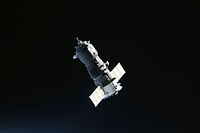
Photo from wikipedia
The understanding of the complexity of the space charge formation and movement inside insulation materials demands a high resolution measurement technique. The Kelvin Probe Force Microscopy (KPFM) can fulfill this… Click to show full abstract
The understanding of the complexity of the space charge formation and movement inside insulation materials demands a high resolution measurement technique. The Kelvin Probe Force Microscopy (KPFM) can fulfill this demand. The KPFM delivers the data of the locally varying surface potential. They can be differentiated twice together with a reliable statistical approach to overcome the noise problem in the experimental surface potential data. In this way, we get the locally varying space charges according to the Poisson equation. This statistical approach has been tested by comparing the calculated space charge distributions from simulated and measured noisy surface potential data. The formation and the movement of space charges with respect to time under unbiased and biased conditions were investigated.
Journal Title: IEEE Transactions on Dielectrics and Electrical Insulation
Year Published: 2017
Link to full text (if available)
Share on Social Media: Sign Up to like & get
recommendations!